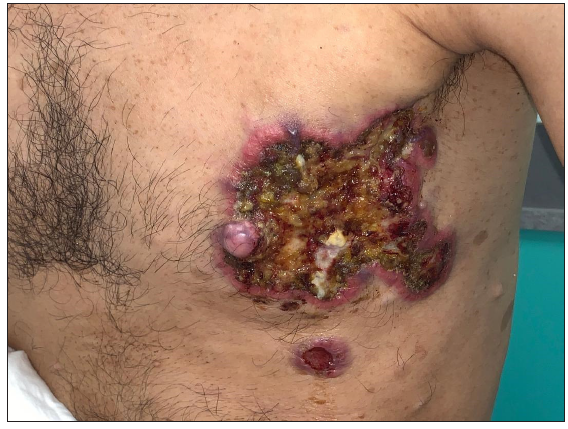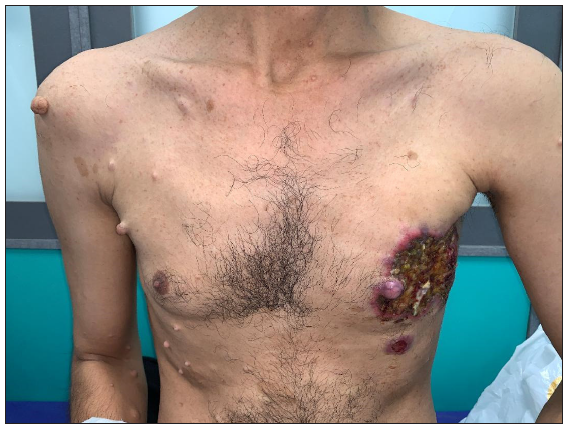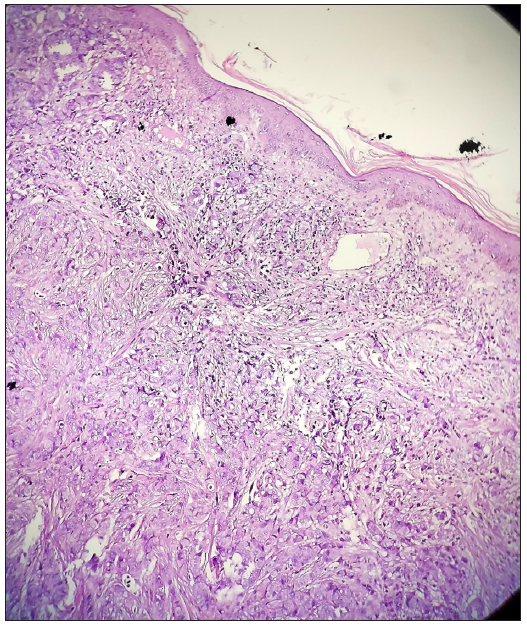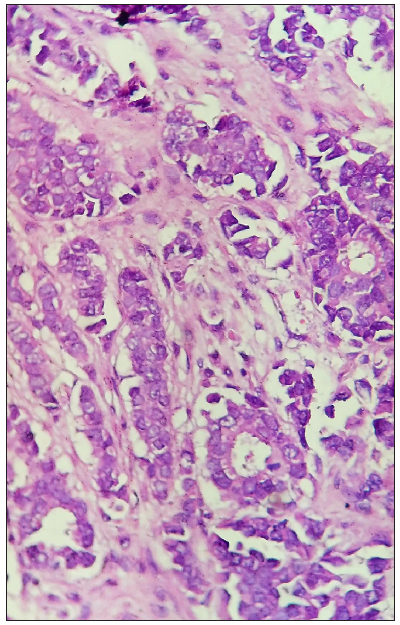Dear Editor,
Neurofibromatosis type 1 (NF1) is an uncommon genetic disorder that predominantly impacts the nervous system and the skin. This condition follows an autosomal dominant inheritance pattern, with an estimated occurrence rate of 1 in every 3,000 individuals.1 NF1 is defined by the presence of numerous neurofibromas and café-au-lait spots. NF1 is also linked to a heightened risk of various cancers, with intracranial gliomas and malignant peripheral nerve sheath tumours being the most reported ones.1 Additionally, individuals diagnosed with NF1 have an increased likelihood of developing breast cancer.1 In women, the association of neurofibromatosis with breast cancer has been confirmed. However, in man, as breast cancer is rare, this association has not yet been fully elucidated.2
This report presents a case of breast cancer in a man with neurofibromatosis, highlighting the potential genetic link between NF1 and male breast cancer and stressing the significance of implementing breast cancer screening protocols for men who have been diagnosed with NF1.
A 38-year-old man was referred to our centre due to a non-healing ulcer on the left side of his chest for one year. He had been diagnosed with NF1 at the age of eight. On examination, a necrotic ulcer with a raised border, measuring approximately 10x12 cm, was observed on the left breast. The border of the ulcer was noted to be firm, irregular, and adherent to underlying tissue. The nipple was destroyed by the ulcer. Numerous café-au-lait spots, neurofibromas, and axillary lentigines were observed on the extremities and trunk [Figures 1 and 2]. No axillary lymphadenopathy was observed. A biopsy of the raised border of the ulcer revealed invasive ductal carcinoma [Figures 3a and 3b]. Subsequently, the patient was referred to a surgeon for additional assessment and management. There was no history of breast, ovarian, or prostate malignancy in his family; nonetheless, his mother had a history of neurofibromatosis.

Export to PPT

Export to PPT

Export to PPT

Export to PPT
Male breast cancer is an uncommon yet acknowledged condition, representing approximately 1% of all cases of breast cancer. It may manifest at any age, although it usually occurs between the ages of 60 and 70 years. The association of neurofibromatosis with male breast cancer is exceptionally rare, with fewer than 10 cases reported in the literature.2 Consistent with our case, most reported cases have occurred at relatively younger ages, typically below 50 years. This observation may suggest a possibility of a genetic connection between NF1 and male breast cancer.
NF1 is attributed to the inactivation of the Neurofibromin 1 (NF1) gene, which is situated in the pericentromeric area of the long arm of chromosome 17. The NF1 gene is possibly a tumour suppressor gene.3
Women with NF1 have been observed to have a higher risk of breast cancer compared to the general population. This risk is up to five times higher before 50 years of age and 3.5 times higher overall.4 However, the likelihood of men with NF1 developing breast cancer is still not well understood.2 In men with NF1, breast cancer is often identified at a more advanced stage, due to the presence of pre-existing multiple cutaneous lumps, which can obscure the detection of the breast lump.5 Additionally, limited awareness of this association among healthcare providers, coupled with the absence of specific screening guidelines for men with NF1, contributes to delayed diagnosis.2,5
In breast screening guidelines, only women with NF1 have been addressed, and it is advised that they undergo high-risk screening programs. It is recommended that individuals in the NF1 population begin annual mammograms at the age of 30 years, and consider the use of breast magnetic resonance imaging with contrast between the ages of 30 and 50 years.4
Due to the lack of evidence-based guidelines specific to the male population with NF, breast cancer management involved the same principles as the general population.5 This includes options such as surgery, chemotherapy, radiation therapy, and targeted therapies. However, it is important to note that there have been reports suggesting that the risk of developing fibrosarcoma as a secondary effect of radiation therapy is heightened when radiotherapy is deemed necessary.6 Furthermore, there are hypotheses suggesting that tamoxifen may exhibit reduced efficacy in cancers associated with NF1 mutations.7
In this report, emphasis was placed on highlighting the association between male breast cancer and NF1 to raise clinical awareness of the possibility of association between the two. Furthermore, this report aims to provide evidence so that men with NF1 are monitored for breast cancer risk with the same diligence as is applied to women with NF1.
留言 (0)